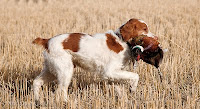Breed of the Week: The Stichelhaar
Developed in the mid to late 1800s, the Deutsch Stichelhaar also known as the German Rough-haired (or Broken-Coated) Pointer, is best known as one of the four key ingredients in the make-up of the Deutsch Drahthaar (German Wirehaired Pointer). But that is about all many know about the breed, if that. I am sure that the vast majority of hunters and gundog enthusiasts have never even heard of the Stichelhaar.
Here's an excerpt from the breed chapter in Pointing Dogs, Volume One.
Here's an excerpt from the breed chapter in Pointing Dogs, Volume One.
When I first started to photograph dogs and compile notes for this book, I chose to study the better known breeds since it was much easier to find information on them. And, besides, I knew where to find hunters who owned some. But when I started looking into the more obscure breeds, things got a bit trickier. Not only was solid information harder to find, but tracking down owners or breeders of some breeds proved to be difficult. In the case of the Stichelhaar, not only did it take some digging, I also needed a bit of luck to finally see one in the flesh.
At some point in every book or article explaining how the German Wirehaired Pointer was developed, a breed known as the Stichelhaar is mentioned. Some GWP histories even provide a brief description of the Stichelhaar’s appearance or hunting ability, but most don’t even offer that. In fact, I’ve even read that the Stichelhaar was extinct. So I had a heck of a time finding information on the breed and could not even confirm that is was still around. The only illustrations I could find were old paintings or fuzzy black and white photographs in long out of print magazines and books. After a while, I started to think that maybe the Stichelhaar really was extinct.
Then, in 2001, I attended a hunt in northern Germany organized by Hans Schmidt, a renowned breeder of long-haired Weimaraners. While there, I asked him if he knew anything about the Stichelhaar. Expecting him to tell me that the breed was extinct, I was stunned when he replied, “Oh, yes, there are a number of them in the area. I see them sometimes when I am out hunting. They are strong hunting dogs—a very old breed you know.” He then told me that a Stichelhaar breeder lived not too far away from him and suggested that we call him to arrange a meeting! Twenty-four hours later, I was at the home of Elso Kratzenberg, the secretary of the Deutsch Stichelhaar Verein.
Standing in Herr Kratzenberg’s driveway, we exchanged handshakes and introductions and took a few minutes to discuss the kinds of photos I wanted to take. Once we had agreed on a plan, he let his dogs out of the house and into the yard. As the two big, rough-and-ready dogs came bounding up toward us, I couldn’t help feeling like the scientist in Jurassic Park when he laid eyes on a real-life dinosaur. Finally, right there in front of me, were living, breathing, tail-wagging Stichelhaars, a breed I thought had gone the way of the dodo bird.
Nowadays, thanks to the internet, there is a lot more information about the Stichelhaar available. Even the German breed club has a website. Nevertheless, the breed still is and always has been a marginal player on the German gundog scene. For most of its history is has been barely hanging on. Here's another except:
I have only seen a few Stichelhaars, all in northern Germany. I have spoken to a couple of owners/breeders including the secretary of the original club. I’ve read a few copies of the club’s newsletter and have followed the ups and downs of the breed via German websites and forums. I am far from an expert, but I certainly know more about the breed now than when I first read that it was extinct. The first time I photographed Stichelhaars, I got the impression that they were more like Griffons than German Wirehaired Pointers. They seemed fairly laid-back and easygoing. Their coats seemed longer and harsher than many of the GWP coats I’ve seen, but not as bushy as the coats on some Griffons. In the field they showed a lot of drive, ran at a medium gallop and pointed staunchly. In the water, they swam like otters
A few years after I had seen Stichelhaars for the first time, I photographed a number of Cesky Fouseks in the Czech Republic. After the photo session and interviews with Cesky Fousek owners and breeders, I compared the photos and written notes I made about the Fousek to the ones I had made of the Stichelhaar. The similarities were striking. I concluded that the two breeds do indeed represent a sort of “same church, different pew” situation. In terms of look and performance they are, for all intents and purposes, identical. The divisions between them are merely political.
Unfortunately for the Stichelhaar, it is club politics that now threaten its survival. Infighting among club members and the struggle for control of the Stichelhaar’s future is coming dangerously close to killing the breed. From what I have seen in the field, forest and water, it would be a crying shame if the breed ended up going the way of the dodo. I sincerely hope that cool heads and reason will prevail.
Read more about the breed, and all the other pointing breeds from Continental Europe, in my book Pointing Dogs, Volume One: The Continentals





















3 comments: